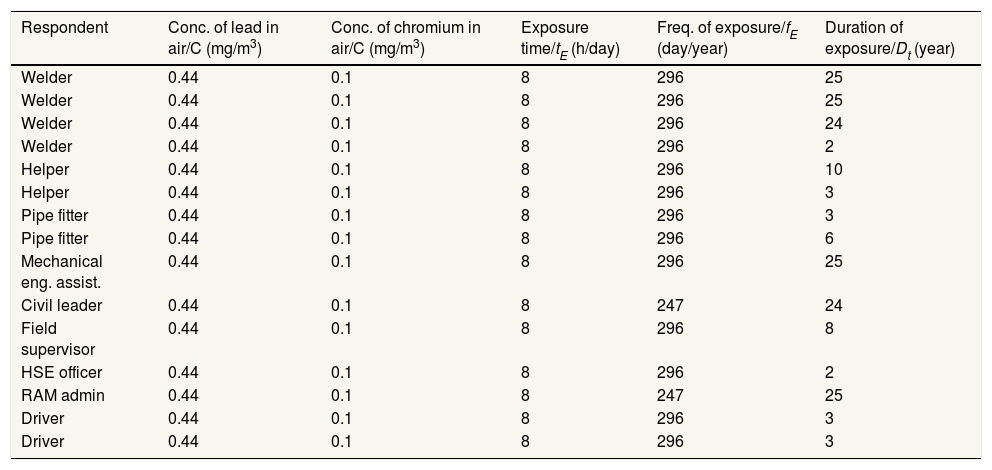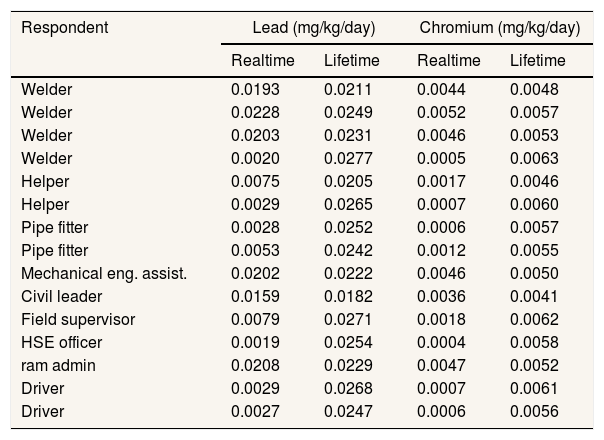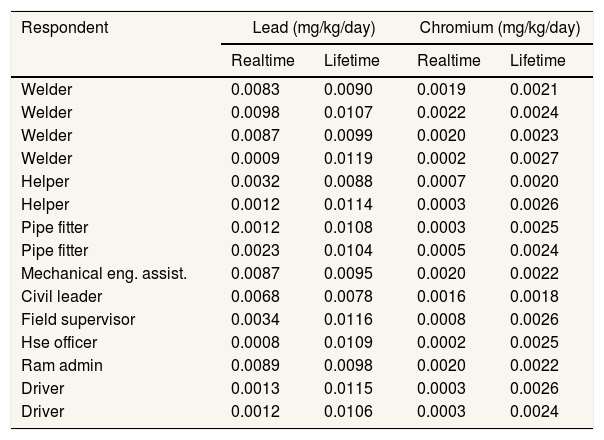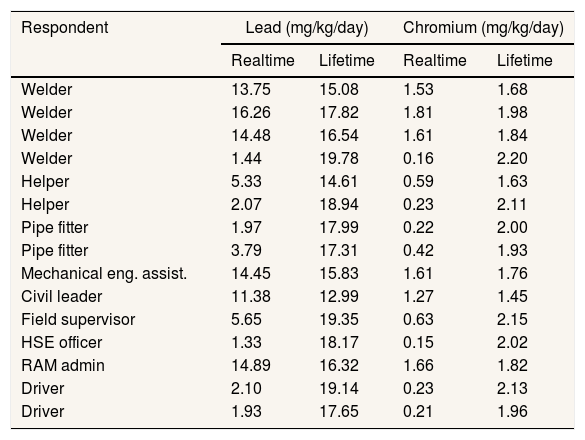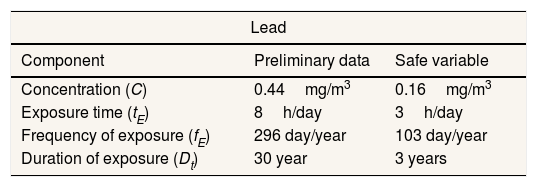
The 3rd International Nursing and Health Sciences Students and Health Care Professionals Conference (INHSP)
More infoThe workshop (pipe repair place) owned by PT. X is potential for heavy metal exposure which can exceed the quality standards. This study is to identify and analyze the risk of heavy metal exposure from the production process and compare it with the quality standards for the workplace that have been set by the government.
MethodsThis research is a quantitative study using the method of environmental health risk analysis (EHRA).
ResultThe concentration of risk agents that could cause adverse health effects of non-carcinogenic due to lead exposure was 15 workers both realtime and lifetime, chromium exposure was 6 workers in realtime and 15 workers for lifetime. While the results of carcinogenic effects due to lead exposure were 1 worker for lifetime and chromium was 15 workers both realtime and lifetime.
ConclusionEfforts to control heavy metals can be carried out through technical engineering, administrative control, and personal protective equipment.
Air pollution caused by exposure to heavy metals is very influential in the long term. Also, heavy metal pollutants are suspended in the air and can move around to the most remote areas. Because heavy metal pollutants are contained in dust floating in the ambient air. When inhaled by humans through the respiratory tract, it can penetrate the inside of the lungs, into blood vessels to the heart. The heavy metal is contained in particulates PM2.5.1
Environmental health risk analysis is an assessment of health risks that may occur at any time in a human population at risk. This predictive assessment produces quantitative risk characteristics, risk management options and communication strategies to minimize these risks.2 Environmental quality data with agent-specific and site-specific, anthropometric characteristics and activity patterns of the exposed population are required for this study.3
MethodsVariablesEmployment and epidemiology: place and work unit, length of work, elements of protection, hygiene methods in the workplace, the workload on weekdays, presence of protection protocols, reasons for committing violations and the person responsible answer for referral, date of appearance of symptoms, positive and negative tests, pre-test contacts, isolation and characteristics, and return to work.
Data collectionThe questionnaire was distributed directly to the workshop workers by direct contact, conduct several interview questions with management Data collection that include the concentration of heavy metals in the air, questionnaires, and interviews.
Data analysisThis research was a quantitative study that used the method of environmental health risk analysis (EHRA). The tools and materials were: stationery; Air Sampler Impinger; Questionnaire sheets; EHRA Guidelines; Monitoring results document; Field documentations and activities. Meanwhile, to determine the heavy metal content, it was carried out by a third party, namely PT. Secondary.
To analyze the value of lead and chromium heavy metal intake from the intake of inhalation agents referred to the Ministry of Health, the implementation steps were:
Exposure assessmentIn analyzed the exposure to the value of Chromium, it was done by calculating the intake or intake of the risk agent. In this study, the intake calculation was carried out in the inhalation (inhalation) exposure pathway with the formula as follows:4,5
Risk characterization was the final stage of this research method. Risk characterization aimed to determine the risk of the agent to be analyzed. In the ARKL guidelines, risk characterization was divided into 2, namely carcinogenic and non-carcinogenic. Based on the EPA, lead and chromium (VI) are carcinogenic metals, so to determine the level of carcinogenic risk, the calculation is used as follows:
Steps taken to calculate the risk characterization for non-cancerous effects, it could be seen by dividing the Intake value by the RfD or RfC value as follows5:
ResultResearch environmental conditionsThe population in this study was known to be 15 people, consisting of 4 welder members, 2 helpers, 2 pipefitters, 1 mechanical engineering assistant, 1 civil leader, 1 field supervisor, 1 HSE officer, 1 admin RAM, and 2 drivers. The sample was all employees who work in the workshop. The sampling method was the total population.
The formal working days were 5 working days, Monday to Friday, then 2 days off, but they make a shift schedule for Saturday, Sunday and overnight for a week for 1 team each. The sources of exposure to Lead and Chromium in the Workshop were from welding, cutting, soldering/brazing, and grinding. The workshop did not have a special room to carry out these activities, so the warehouse and rest area for workers became one in the workshop. So workers can be easily exposed to these heavy metals.
Concentrations of lead and chromium in airSee Table 1.
Secondary data on the distribution of lead and chromium concentrations in the air of the 2017 Workshop.
See Table 2.
Duration of workshop staff exposure.
| Respondent | Conc. of lead in air/C (mg/m3) | Conc. of chromium in air/C (mg/m3) | Exposure time/tE (h/day) | Freq. of exposure/fE (day/year) | Duration of exposure/Dt (year) |
|---|---|---|---|---|---|
| Welder | 0.44 | 0.1 | 8 | 296 | 25 |
| Welder | 0.44 | 0.1 | 8 | 296 | 25 |
| Welder | 0.44 | 0.1 | 8 | 296 | 24 |
| Welder | 0.44 | 0.1 | 8 | 296 | 2 |
| Helper | 0.44 | 0.1 | 8 | 296 | 10 |
| Helper | 0.44 | 0.1 | 8 | 296 | 3 |
| Pipe fitter | 0.44 | 0.1 | 8 | 296 | 3 |
| Pipe fitter | 0.44 | 0.1 | 8 | 296 | 6 |
| Mechanical eng. assist. | 0.44 | 0.1 | 8 | 296 | 25 |
| Civil leader | 0.44 | 0.1 | 8 | 247 | 24 |
| Field supervisor | 0.44 | 0.1 | 8 | 296 | 8 |
| HSE officer | 0.44 | 0.1 | 8 | 296 | 2 |
| RAM admin | 0.44 | 0.1 | 8 | 247 | 25 |
| Driver | 0.44 | 0.1 | 8 | 296 | 3 |
| Driver | 0.44 | 0.1 | 8 | 296 | 3 |
For carcinogenic or cancer-causing exposures, the calculations were almost the same, but there was a slight difference, namely the average period of exposure to cancer, which was 70 years (Tables 3 and 4).
Distribution of non-carcinogenic effect intake (intake) values based on real-time and lifetime lead exposure to individual workshop employees.
| Respondent | Lead (mg/kg/day) | Chromium (mg/kg/day) | ||
|---|---|---|---|---|
| Realtime | Lifetime | Realtime | Lifetime | |
| Welder | 0.0193 | 0.0211 | 0.0044 | 0.0048 |
| Welder | 0.0228 | 0.0249 | 0.0052 | 0.0057 |
| Welder | 0.0203 | 0.0231 | 0.0046 | 0.0053 |
| Welder | 0.0020 | 0.0277 | 0.0005 | 0.0063 |
| Helper | 0.0075 | 0.0205 | 0.0017 | 0.0046 |
| Helper | 0.0029 | 0.0265 | 0.0007 | 0.0060 |
| Pipe fitter | 0.0028 | 0.0252 | 0.0006 | 0.0057 |
| Pipe fitter | 0.0053 | 0.0242 | 0.0012 | 0.0055 |
| Mechanical eng. assist. | 0.0202 | 0.0222 | 0.0046 | 0.0050 |
| Civil leader | 0.0159 | 0.0182 | 0.0036 | 0.0041 |
| Field supervisor | 0.0079 | 0.0271 | 0.0018 | 0.0062 |
| HSE officer | 0.0019 | 0.0254 | 0.0004 | 0.0058 |
| ram admin | 0.0208 | 0.0229 | 0.0047 | 0.0052 |
| Driver | 0.0029 | 0.0268 | 0.0007 | 0.0061 |
| Driver | 0.0027 | 0.0247 | 0.0006 | 0.0056 |
Distribution of intake (intake) carcinogenic effects based on realtime and lifetime lead and chromium exposures to individual workshop employees.
| Respondent | Lead (mg/kg/day) | Chromium (mg/kg/day) | ||
|---|---|---|---|---|
| Realtime | Lifetime | Realtime | Lifetime | |
| Welder | 0.0083 | 0.0090 | 0.0019 | 0.0021 |
| Welder | 0.0098 | 0.0107 | 0.0022 | 0.0024 |
| Welder | 0.0087 | 0.0099 | 0.0020 | 0.0023 |
| Welder | 0.0009 | 0.0119 | 0.0002 | 0.0027 |
| Helper | 0.0032 | 0.0088 | 0.0007 | 0.0020 |
| Helper | 0.0012 | 0.0114 | 0.0003 | 0.0026 |
| Pipe fitter | 0.0012 | 0.0108 | 0.0003 | 0.0025 |
| Pipe fitter | 0.0023 | 0.0104 | 0.0005 | 0.0024 |
| Mechanical eng. assist. | 0.0087 | 0.0095 | 0.0020 | 0.0022 |
| Civil leader | 0.0068 | 0.0078 | 0.0016 | 0.0018 |
| Field supervisor | 0.0034 | 0.0116 | 0.0008 | 0.0026 |
| Hse officer | 0.0008 | 0.0109 | 0.0002 | 0.0025 |
| Ram admin | 0.0089 | 0.0098 | 0.0020 | 0.0022 |
| Driver | 0.0013 | 0.0115 | 0.0003 | 0.0026 |
| Driver | 0.0012 | 0.0106 | 0.0003 | 0.0024 |
The workshop was carried out in 2 stages, by finding the value of the Risk Quotient (RQ) and Excess Cancer Risk (ECR). In the RQ, an RfC (Reference Concentration) value was required for each heavy metal, lead 0.0014mg/kg/day and chromium 0.00286mg/kg/day. The ECR requires a CSF (Cancer Slope Factor) value for each heavy metal CSF: lead 0.0085mg/kg/day and chromium 0.5mg/kg/day. Apart from RQ and ECR, the calculation of risk characteristics also required a non-carcinogenic intake for RQ and a carcinogenic intake for ECR.
After obtaining the RQ value, the following assumptions were used:
- •
If RQ≤1, then the hazard concentration is not at risk of causing non-carcinogenic health effects.
- •
If RQ>1, then hazard concentrations are at risk of causing non-carcinogenic health effects.
While the characteristics for the cancer effect could be determined by multiplying the Intake value with the CSF value.
After obtaining the ECR value, the following assumptions were used:
- •
If the ECR≤10−4, then the hazard concentration is not yet at risk of causing carcinogenic health effects.
- •
If the ECR>10−4, then the hazard concentration is at risk of causing carcinogenic health effects.
In conclusion, at realtime exposure, all employees exposed to chromium were at risk of cancer effects, and none of the employees exposed to lead were at risk of cancer effects. Also, a lifetime exposure, all employees exposed to chromium had a risk of cancer effects, and 1 employee exposed to lead had a risk of cancer effects (Table 5).
Distribution of Risk Quotient (RQ) values based on realtime and lifetime exposure of lead and chromium to individual workshop employees.
| Respondent | Lead (mg/kg/day) | Chromium (mg/kg/day) | ||
|---|---|---|---|---|
| Realtime | Lifetime | Realtime | Lifetime | |
| Welder | 13.75 | 15.08 | 1.53 | 1.68 |
| Welder | 16.26 | 17.82 | 1.81 | 1.98 |
| Welder | 14.48 | 16.54 | 1.61 | 1.84 |
| Welder | 1.44 | 19.78 | 0.16 | 2.20 |
| Helper | 5.33 | 14.61 | 0.59 | 1.63 |
| Helper | 2.07 | 18.94 | 0.23 | 2.11 |
| Pipe fitter | 1.97 | 17.99 | 0.22 | 2.00 |
| Pipe fitter | 3.79 | 17.31 | 0.42 | 1.93 |
| Mechanical eng. assist. | 14.45 | 15.83 | 1.61 | 1.76 |
| Civil leader | 11.38 | 12.99 | 1.27 | 1.45 |
| Field supervisor | 5.65 | 19.35 | 0.63 | 2.15 |
| HSE officer | 1.33 | 18.17 | 0.15 | 2.02 |
| RAM admin | 14.89 | 16.32 | 1.66 | 1.82 |
| Driver | 2.10 | 19.14 | 0.23 | 2.13 |
| Driver | 1.93 | 17.65 | 0.21 | 1.96 |
Data from the calculation of risk control options for non-cancerous effects on safe lead and chromium exposures to workshop employees.
| Lead | ||
|---|---|---|
| Component | Preliminary data | Safe variable |
| Concentration (C) | 0.44mg/m3 | 0.16mg/m3 |
| Exposure time (tE) | 8h/day | 3h/day |
| Frequency of exposure (fE) | 296 day/year | 103 day/year |
| Duration of exposure (Dt) | 30 year | 3 years |
| Chromium | ||
|---|---|---|
| Component | Preliminary data | Safe variable |
| Concentration (C) | 0.1mg/m3 | 0.07mg/m3 |
| Exposure time (tE) | 8h/day | 6h/day |
| Frequency of exposure (fE) | 296 day/year | 200 day/year |
| Duration of exposure (Dt) | 30 years | 3 years |
According to research conducted by Tan (2016),8 it showed that the concentration of heavy metals in indoor dust was influenced by local human activities and atmospheric transportation could have harmful effects on human health. Also, research has shown that heavy metals could cause adverse health effects.9 The International Agency for Research on Cancer (IARC) has classified chromium, and lead as carcinogenic and non-carcinogenic elements. Heavy metals such as Cr and Pb are widespread environmental pollutants and can cause harmful health effects, such as cancer.10 Some examples of carcinogenic effects are respiratory disease, cardiovascular death, nervous system damage, and slow growth.11
In the workshop, it is necessary to carry out an analysis of the health risks of the work environment. The values of Risk Quotient (RQ) and Excess Cancer Risk (ECR) in the workshop work environment exceed the safe values, which are more than 1 and more than 10−4. To reduce the RQ and ECR concentrations, it can control the risk agent concentration and contact time which is done by reducing the frequency and time of exposure.
The concentration of lead and chromium heavy metals in the workshop is directly proportional to the busy work of the workshop. From the results of the questionnaire given, workshop workers complained about several diseases that indicated the worker had experienced non-carcinogenic effects such as appetite and weight loss, muscle and joint pain, fever, itching, and severe headaches. When equated with the results of the calculation of this analysis, there are several workers whose RQ values exceed 1. This is evidence that these workers have experienced non-carcinogenic effects. Also, the non-carcinogenic effects and carcinogenic effects are getting worse because more than half of the respondents smoke actively, both moderate to mild smoker status.
Control of the risk of dangerous heavy metals can be carried out using the OHSAS 18001:200712 guidelines which are more specific with the OHS/Hazard Control Hierarchy approach, namely Elimination, Substitution, Engineering Control, Administrative Control, and Personal Protectice Equipment. Considering that welding work is the most important thing in the continuity of the Workshop, Elimination and Substitution cannot be used. One of to prevent exposure heavy metals and to minimalize the risk potential occupational disease and occupational accident with implementation of occupational health and safety management system.13
ConclusionThe results showed the concentration of risky agents that could cause non-carcinogenic adverse health effects due to real-time exposure to lead by 15 workers and chromium by 6 workers. In the lifetime exposure to lead and chromium as many as 15 workers. Furthermore, the risk agents that could cause carcinogenic health effects due to real-time chromium exposure were 15 workers. In the lifetime exposure to lead as much as 1 worker and chromium as much as 15 workers. For the calculation of the population of workshop workers, the non-cancer risk due to real-time exposure was Lead, while for lifetime exposure was lead and chromium. Also, the cancer risk due to real-time and lifetime exposure was chromium.
Conflicts of interestThe authors declare no conflict of interest.
Peer-review under responsibility of the scientific committee of the 3rd International Nursing, Health Science Students & Health Care Professionals Conference. Full-text and the content of it is under responsibility of authors of the article.



